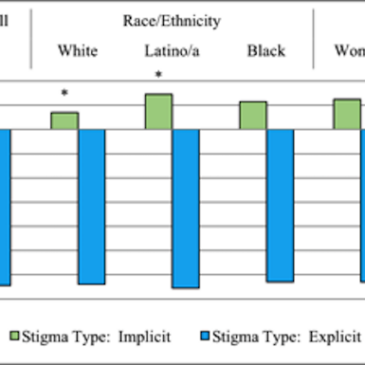Here at the BASIS, we are guided by our mission to increase awareness, to reduce stigma, and ultimately, to improve lives. More than 10 years ago, in an op-ed for The BASIS, we highlighted the dehumanization of patients with addiction that persists in our society, and the consequent challenges to recovery that it poses. In the decade since the publication of the op-ed, has there been sufficient progress in reducing stigma? Sadly, despite educational efforts, a knee-jerk reaction to a patient with addiction still is not uncommon. Too often, we are quick to associate addiction with some sort of moral failing, instead of recognizing it as a medical condition. This week, we review an empirical study by Dr. Magdalena Kulesza and colleagues that explored implicit and explicit beliefs that the public holds about addiction, and the role social identity plays in shaping those beliefs.
What was the research question?
Are people’s beliefs about people who inject drugs (PWIDs) influenced by race and gender?
What did the researchers do?
Kulesza and colleagues recruited volunteers from the Project Implicit research website to participate in the study. In the study sample of 899 enrollees, the researchers used a computer-based reaction time task to assess participants’ implicit attitudes related to addiction stigma. To assess the participants’ explicit attitudes towards addiction stigma, the researchers provided a brief vignette describing an individual arrested for heroin possession (i.e., PWID), and asked whether s/he should be punished or helped1. Depending on their condition, study participants saw images of Black man/woman PWIDs, White man/woman PWIDs, or Latino/Latina PWIDs. Following data collection, the researchers conducted an analysis of variance (ANOVA) to determine whether there are any statistically significant differences between the different PWID categories.
What did they find?
As the Figure shows, the researchers found a small implicit tendency to associate PWIDs with punishment, rather than help; on the other hand, on an explicit level, participants reported a preference for helping PWIDs, rather than punishing them. In other words, while participants outwardly express compassionate views towards PWIDs, their implicit attitudes tend to be harsher. Participants’ explicitly reported attitudes did not vary based on the PWID’s race/ethnicity or gender. However, on the implicit addiction stigma measure, participants presented with images of Latino/a PWIDs were more likely to be rated as deserving punishment than participants presented with images of White PWIDs.

Figure. Estimates of implicit and explicit addiction stigma measures by study conditions. Adapted from Magdalena et.al. (2016). Positive scores indicate a tendency to associate PWIDs with punishment, rather than help. Negative scores indicate a tendency to associate PWIDs with help, rather than punishment. Bars with * above them represent variables that are statistically significant. Click image to enlarge.
Why do these findings matter?
The research contributes towards developing a more nuanced understanding of addiction stigma, which is a multi-faceted concept. The findings also make a novel contribution in providing a better understanding of the relationship between addiction stigma and other sources of bias. Challenging people’s implicit beliefs about punishing PWIDs—especially Latino/a PWID—might be key to reducing stigma and improving access to help. Becoming aware of our own implicit biases is key to challenging them, as this article describes.
Every study has limitations. What are the limitations in this study?
The study sample was recruited online, and composed of a disproportionately large share of participants (30.4%) with an advanced degree (e.g., PhD, MD) compared to the general population. This consequently limits the generalizability of the study. Further, some of the preliminary findings of the study will require additional research to be implementable from a policy or programmatic standpoint. For example, it is impossible to determine whether participants’ positive explicit evaluations reflected their true beliefs, or their desire to appear unbiased and progressive.
For more information:
For help with finding substance use treatment please click here to visit the Substance Abuse and Mental Health Services (SAMHSA) webpage.
— Pradeep Singh
What do you think? Please use the comment link below to provide feedback on this article.
________________
[1] In brief, implicit attitudes are attitudes that people hold without conscious awareness and explicit attitudes are attitudes of which people are consciously aware. Please visit the Project Implicit research website for more details on the explicit and implicit bias measures designed to assess addiction stigma.




